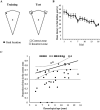The developmental trajectories of children's reorientation to global and local properties of environmental geometry
- PMID: 35925741
- PMCID: PMC11115358
- DOI: 10.1037/xge0001265
The developmental trajectories of children's reorientation to global and local properties of environmental geometry
Abstract
The way in which organisms represent the shape of their environments during navigation has been debated in cognitive, comparative, and developmental psychology. While there is evidence that adult humans encode the entire boundary shape of an environment (a global-shape representation), there are also data demonstrating that organisms reorient using only segments of the boundary that signal a goal location (a local-shape representation). Developmental studies offer unique insights into this debate; however, most studies have used designs that cannot dissociate the type of boundary-shape representation that children use to guide reorientation. Thus, we examined the developmental trajectories of children's reorientation according to local and global boundary shape. Participants aged 6-12 years were trained to find a goal hidden in one corner of a virtual arena, after which they were required to reorient in a novel test arena. From 10.5 years, children performed above chance when the test arena permitted reorientation based only on local-shape (Experiment 2), or only global-shape (Experiment 3) information. Moreover, when these responses were placed into conflict, older children reoriented with respect to global-shape information (Experiment 4). These age-related findings were not due to older children being better able to reorient in virtual environments per se: when trained and tested within the same environment (Experiment 1), children performed above chance from 6 years. Together, our results suggest (a) the ability to reorient on the basis of global- and local-shape representations develops in parallel, and (b) shape-based information is weighted to determine which representation informs reorientation. (PsycInfo Database Record (c) 2024 APA, all rights reserved).
Figures





Similar articles
-
Thinking outside of the box: Transfer of shape-based reorientation across the boundary of an arena.Cogn Psychol. 2016 Jun;87:53-87. doi: 10.1016/j.cogpsych.2016.04.001. Epub 2016 May 28. Cogn Psychol. 2016. PMID: 27240027
-
Crossing boundaries: Global reorientation following transfer from the inside to the outside of an arena.J Exp Psychol Anim Learn Cogn. 2019 Jul;45(3):322-337. doi: 10.1037/xan0000206. Epub 2019 May 9. J Exp Psychol Anim Learn Cogn. 2019. PMID: 31070431 Free PMC article.
-
Does a row of objects comprise a boundary? How children miss the forest for the trees in spatial navigation.Dev Psychol. 2023 Dec;59(12):2397-2407. doi: 10.1037/dev0001638. Epub 2023 Oct 12. Dev Psychol. 2023. PMID: 37824230
-
Thinking outside of the box II: Disrupting the cognitive map.Cogn Psychol. 2019 Feb;108:22-41. doi: 10.1016/j.cogpsych.2018.11.001. Epub 2018 Dec 11. Cogn Psychol. 2019. PMID: 30544029
-
Spatial reorientation in large and small enclosures: comparative and developmental perspectives.Cogn Process. 2008 Dec;9(4):229-38. doi: 10.1007/s10339-008-0202-6. Epub 2008 Jan 15. Cogn Process. 2008. PMID: 18196304 Review.
References
-
- Buckley M., Holden L., Smith A., & Haselgrove M. (2022). The developmental trajectories of children’s reorientation to global and local properties of environmental geometry [Dataset]. 10.17605/OSF.IO/Q83N7/ - DOI - PMC - PubMed

